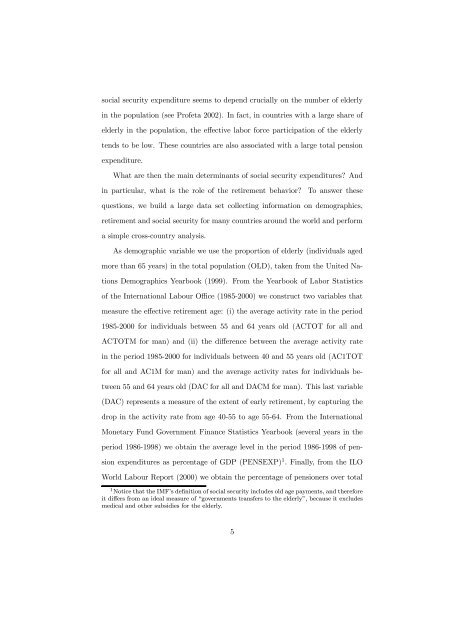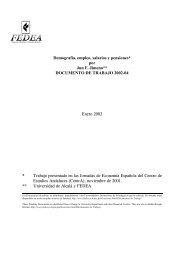The Evolution of Retirement by J. Ignacio Conde-Ruiz* Vincenzo ...
The Evolution of Retirement by J. Ignacio Conde-Ruiz* Vincenzo ...
The Evolution of Retirement by J. Ignacio Conde-Ruiz* Vincenzo ...
You also want an ePaper? Increase the reach of your titles
YUMPU automatically turns print PDFs into web optimized ePapers that Google loves.
social security expenditure seems to depend crucially on the number <strong>of</strong> elderly<br />
in the population (see Pr<strong>of</strong>eta 2002). In fact, in countries with a large share <strong>of</strong><br />
elderly in the population, the effective labor force participation <strong>of</strong> the elderly<br />
tends to be low. <strong>The</strong>se countries are also associated with a large total pension<br />
expenditure.<br />
What are then the main determinants <strong>of</strong> social security expenditures? And<br />
in particular, what is the role <strong>of</strong> the retirement behavior?<br />
To answer these<br />
questions, we build a large data set collecting information on demographics,<br />
retirement and social security for many countries around the world and perform<br />
a simple cross-country analysis.<br />
Asdemographicvariableweusetheproportion<strong>of</strong>elderly(individualsaged<br />
more than 65 years) in the total population (OLD), taken from the United Nations<br />
Demographics Yearbook (1999). From the Yearbook <strong>of</strong> Labor Statistics<br />
<strong>of</strong> the International Labour Office (1985-2000) we construct two variables that<br />
measure the effective retirement age: (i) the average activity rate in the period<br />
1985-2000 for individuals between 55 and 64 years old (ACTOT for all and<br />
ACTOTM for man) and (ii) the difference between the average activity rate<br />
in the period 1985-2000 for individuals between 40 and 55 years old (AC1TOT<br />
for all and AC1M for man) and the average activity rates for individuals between<br />
55 and 64 years old (DAC for all and DACM for man). This last variable<br />
(DAC) represents a measure <strong>of</strong> the extent <strong>of</strong> early retirement, <strong>by</strong> capturing the<br />
drop in the activity rate from age 40-55 to age 55-64. From the International<br />
Monetary Fund Government Finance Statistics Yearbook (several years in the<br />
period 1986-1998) we obtain the average level in the period 1986-1998 <strong>of</strong> pension<br />
expenditures as percentage <strong>of</strong> GDP (PENSEXP) 1 .Finally,fromtheILO<br />
World Labour Report (2000) we obtain the percentage <strong>of</strong> pensioners over total<br />
1 Notice that the IMF’s definition <strong>of</strong> social security includes old age payments, and therefore<br />
it differs from an ideal measure <strong>of</strong> “governments transfers to the elderly”, because it excludes<br />
medical and other subsidies for the elderly.<br />
5






